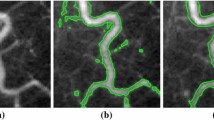Abstract
Various studies on interest point (IP) detection have concluded that maximally stable extremal region (MSER)-based IPs outperform others on repeatability, localization accuracy, robustness, efficiency and covariance to global and local image distortions. Since medical images lack sharp detail, corner IPs are not a suitable choice for them. Instead, MSERs which offer region-based IPs are useful. However, sensitivity of MSERs to image blur and scale makes them less useful practically. In this context, through this paper, following contributions are made—(1) It is proposed to study MSER-based IPs in Intensity Scale Space instead of conventional Scale Space to better understand and mitigate the problem of IP clutter. (2) By modulating the connectivity of previously proposed ER-based IPs (inspired from visual saliency approach), blur and scale sensitivity of region-based IPs is shown to reduce significantly. The newly developed IPs are called ‘blur robust extremal region (BRER)’ IPs. (3) Owing to the global nature of evaluation parameters (like repeatability) for IP detection, the problem of incorrect judgment is highlighted. As a solution to it, three new evaluation parameters called ‘Uniformity Index,’ ‘10 % core distance’ and ‘Informativeness’ are proposed. These indices capture the idea of uniform distribution of IPs over the entire image, IP clutter and the redundancy of registered IP pairs, respectively. Experiments on database of medical images of different modalities and various organs/diseases suggest that proposed BRER IPs are robust to blur and scale. Also, proposed indices of evaluation offer better judgment of quality of image registration.








Similar content being viewed by others
References
Sotiras A, Davatzikos C, Paragios N (2013) Deformable medical image registration: a survey. IEEE Trans Med Imaging 32:1153–1190
Tuytelaars T, Mikolajczyk K (2008) Local invariant feature detectors: a survey. Found Trends Comput Graph Vis 3(3):177–280. doi:10.1561/0600000017
Mikolajczyk K, Tuytelaars T, Schmid C, Zisserman A, Matas J, Schaffalitzky F et al (2005) A comparison of affine region detectors. Int J Comput Vis 65:43–72
Matas J, Chum O, Urban M, Pajdla T (2004) Robust wide-baseline stereo from maximally stable extremal regions. Image Vis Comput 22:761–767
Tuytelaars T, Van Gool LJ (2000) Wide baseline stereo matching based on local, affinely invariant regions. In: BMVC, vol 1. p 4
Mikolajczyk K, Schmid C (2004) Scale and affine invariant interest point detectors. Int J Comput Vis 60:63–86
Tuytelaars T, Van Gool L (1999) Content-based image retrieval based on local affinely invariant regions. In: Visual information and information systems. Springer, Berlin Heidelberg, pp 493–500
Mori G, Ren X, Efros AA, Malik J (2004) Recovering human body configurations: combining segmentation and recognition. In: Proceedings of the 2004 IEEE computer society conference on computer vision and pattern recognition, 2004. CVPR 2004, vol 2, pp II-326–II-333
Ren X, Malik J (2003) Learning a classification model for segmentation. In: Proceedings ninth IEEE international conference on computer vision, 2003, pp 10–17
Bay H, Ess A, Tuytelaars T, Van Gool L (2008) Speeded-up robust features (SURF). Comput Vis Image Underst 110:346–359
Lowe DG (2004) Distinctive image features from scale-invariant keypoints. Int J Comput Vis 60:91–110
Qin D (2010) A comparison study of the local feature detectors. Thesis
Maver J (2010) Self-similarity and points of interest. IEEE Trans Pattern Anal Mach Intell 32:1211–1226
Kalia R, Lee K-D, Samir B, Je S-K, Oh W-G (2011) An analysis of the effect of different image preprocessing techniques on the performance of surf: speeded up robust features. In: 2011 17th Korea-Japan joint workshop on frontiers of computer vision (fcv), pp 1–6
Dahl AL, Aanæs H, Pedersen KS (2011) Finding the best feature detector-descriptor combination. In: 2011 International conference on 3D Imaging, modeling, processing, visualization and transmission (3DIMPVT), pp 318–325
Chao J, Al-Nuaimi A, Schroth G, Steinbach E (2013) Performance comparison of various feature detector-descriptor combinations for content-based image retrieval with JPEG-encoded query images. In: 2013 IEEE 15th international workshop on multimedia signal processing (MMSP), pp 029–034
Işık Ş (2015) A comparative evaluation of well-known feature detectors and descriptors. Int J Appl Math Electron Comput 3:1–6
Kazmi W, Andersen HJ (2015) A comparison of interest point and region detectors on structured, range and texture images. J Vis Commun Image Represent 32:156–169
Forssén P-E, Lowe DG (2007) Shape descriptors for maximally stable extremal regions. In: IEEE 11th international conference on computer vision, 2007. ICCV 2007, pp 1–8
Cheng L, Gong J, Yang X, Fan C, Han P (2008) Robust affine invariant feature extraction for image matching. IEEE Geosci Remote Sens Lett 5:246–250
Miao J, Chu J, Zhang G (2015) Detection of saliency maximally stable color regions. Multimed Tools Appl 74:5845–5860
Faraji M, Shanbehzadeh J, Nasrollahi K, Moeslund TB (2015) Extremal regions detection guided by maxima of gradient magnitude. IEEE Trans Image Process 24:5401–5415
Faraji M, Shanbehzadeh J, Nasrollahi K, Moeslund TB (2015) EREL: extremal regions of extremum levels. In: 2015 IEEE international conference on image processing (ICIP), pp 681–685
Sedgewick R (2003) Algorithms in C++, vol 2. Pearson Education India, Delhi
Nistér D, Stewénius H (2008) Linear time maximally stable extremal regions. In: Computer vision—ECCV 2008. Springer, Berlin Heidelberg, pp 183–196
Kashyap M, Bhattacharya M (2015) Medical image registration using extremal region based interest points. In: International conference on computer graphics, vision and information security (IEEE CGVIS—2015), Bhubaneswar
Filipe S, Alexandre LA (2013) From the human visual system to the computational models of visual attention: a survey. Artif Intell Rev 39:1–47
Yates F (1934) Contingency tables involving small numbers and the χ2 test. Suppl J R Stat Soc 1(2):217–235
Roy S, Bhattacharyya DK (2005) An approach to find embedded clusters using density based techniques. In: Distributed computing and internet technology. Springer, Berlin Heidelberg, pp 523–535
Rosset A, Spadola L, Ratib O (2004) OsiriX: an open-source software for navigating in multidimensional DICOM images. J Digit Imaging 17:205–216
Author information
Authors and Affiliations
Corresponding author
Rights and permissions
About this article
Cite this article
Kashyap, M., Bhattacharya, M. Blur robust extremal region-based interest points for medical image registration. Pattern Anal Applic 21, 45–56 (2018). https://doi.org/10.1007/s10044-016-0563-x
Received:
Accepted:
Published:
Issue Date:
DOI: https://doi.org/10.1007/s10044-016-0563-x




